Transcribed from The Connossieur of November 1911, in the Internet Archive, by Jacqueline Banerjee. The paintings are shown in the order in which they appear there. At the foot of the first page is the information: "[With the exception of the portrait on page 137, the illustrations to this article are reproduced from prints kindly lent by Messrs. H. Graves & Co.]" — the illustration referred to is that of the Duchess of Orleans.

RANZ XAVAR WINTERHALTER was born at Menzenschwand, in the Black Forest, on April 20th, 1806, and he died at Frankfurt in 1873. So that he saw during his life the fall of the Empire dress, the birth of the crinoline, its death, and in the last three years of his life the most awful fashion women have ever permitted to reign. One cannot call the crinoline an ugly fashion; there was something about the big stuff-covered cage that made for charms It had at least the attraction of being exceedingly feminine in a time of great femininity — "prunes, plums, and prisms," as the young ladies were taught to repeat as a daily exercise to give their mouths the correct rosebud appearance, produced not only dainty, simpering dames, but a race of fine women besides. The crinoline also produced a peculiar type of picture, almost a peculiar type of painter, one who was forced to study the whole art of painting stuffs. Not that every capable craftsman cannot paint yards of material, but that, in the case of the crinoline when it appeared in a portrait, it dominated the canvas, swamped the figure, and left little but a little head on the top of great masses of Organdy or Grenadine: yards and yards of still-life to be painted.

The Princess Royal by F. Winterhalter.
Winterhalter, after engraving in his youth at Freiburg, went to Munich in 1823, then in 1828 to Carlsruhe, where he painted a portrait of the Grand Duke Leopold, and so burst into popular favour. The year 1834 saw him in Paris, and the year 1840 saw the birth of the crinoline.
It is, perhaps, no great compliment to an artist [213/32] to bring him in with a whole sackful of silk, and dump him, as it were, before your public with a haberdasher's introduction, "Mr, Winterhalter and the Crinoline," but one is almost forced to do so when such a compelling object flaunts itself on the public notice and refuses to be disregarded. The only marvel is that the crinoline did not swamp Mr. Winterhalter on making his first bow. It certainly captured him, turned the course of his life, made him its slave. However fantastic this may appear, it is, none the less, perfectly true. Winterhalter became a fashionable, the fashionable painter, and lo! the dictates of fashion and the Empress Eugénie (who wore once, in 1859, a crinoline with one hundred and three tulle flounces) spoke the majestic word "Crinoline," and Mr. Winterhalter bowed under the yoke. The task fitted him exactly; he had just the gift of the Victorian grand manner, which is not by any means to be mixed up with THE grand manner, that enabled him to make pictures of real charm out of these women in cages. He followed the direct line of fashionable painters, from Holbein downwards, and certainly had the worst of times to paint in. He managed in his own way to dignify the crinoline. He managed to get a certain sense of space out of the popular portrait arrangements of his time — the curtain, the park, and the vase of flowers. And, beyond that, he certainly knew how to paint a beautiful woman. Any one of his portraits of the Empress Eugénie will tell one that; or, as an example of a really charming picture, look at the Duchess of Orleans holding up a baby; it is delightful.
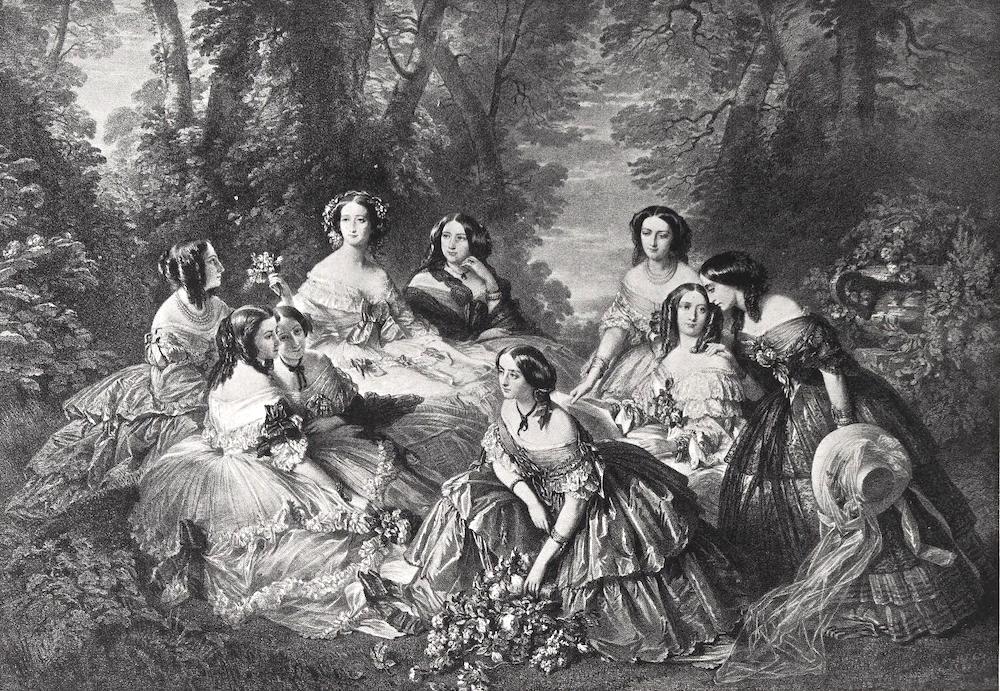
The Empress Eugénie and Her Court by F. Winterhalter.
When one remembers the period of taste in which Winterhalter lived, it is amazing to see how well he avoided the worst influences of his time. His eye must have been constantly dwelling on scenes of truly appalling splendour, on regiments of terrible alabaster figures under glass cases, on miles of hideously embroidered bell-pulls, or whole queues of wax flowers and fruit, seas of antimacassars, and arid plains of horsehair. With this nightmare ever before him, he is not to be too unkindly treated in the annals of art, but deserves every note of respect as one who, in this dreadful time, yet kept the true line of succession alive, and who takes his title and place among the kings of painting, poor king though he be.
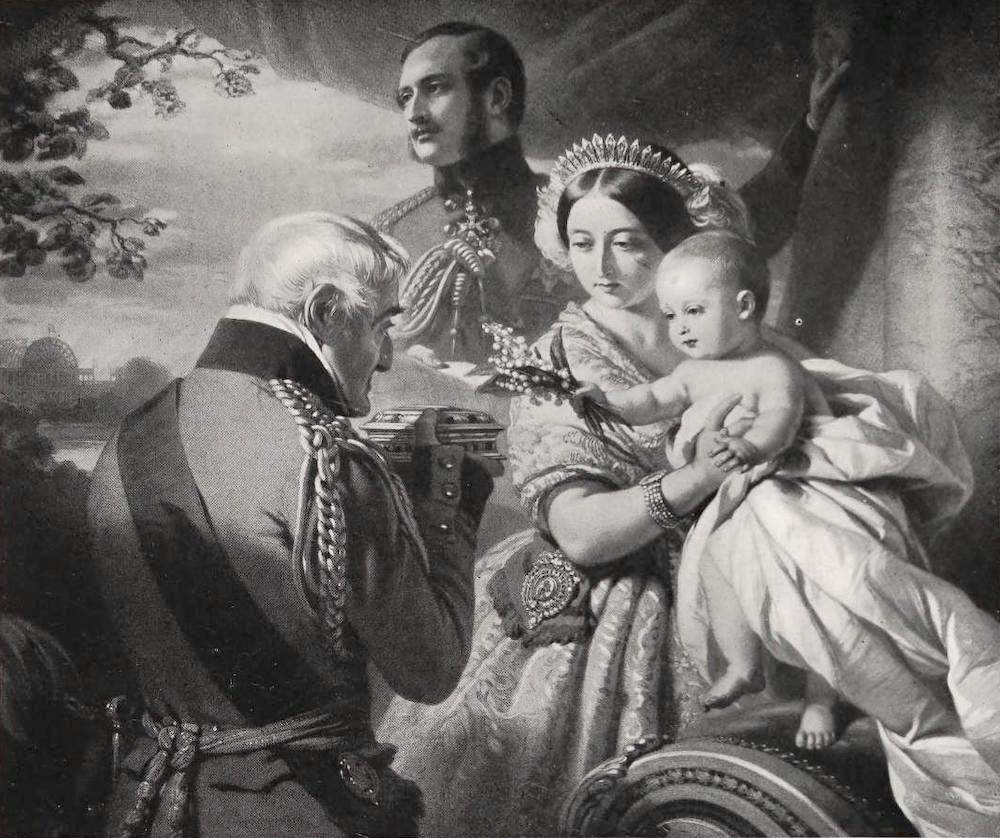
The First of May by F. Winterhalter.
One can see how he was at the mercy of his time when we look at the history of the crinoline. In 1840 began the cage under the voluminous skirt, a small cage at first, just to make the softer materials stand out in graceful folds. The dresses then were very graceful and charming, and gave a revelation of the women in them, a modest sense of the figure. One flounce was considered quite correct, and more was to go one better than the fashion. In 1844 the skirts still kept full and the one flounce had grown into two or three, but the ordinary walking dress was flounceless and plain. In 1846 the flounces increased to between five and six, and no end of tartan in very big designs was worn, the very dickens to paint, especially if one happened to be a fashionable portrait painter, and a careful one at that. All these good ladies, the Duchess d'Aumale, the Queen of the Belgians, the princess of this or that, numbers of them, including our own Queen Victoria — for Winterhalter basked in the smiles of royalty — were anxious enough to have their dressmakers perpetuated as well as themselves. In 1851 the ladies began to wear tight little jackets of white over the wildest checks one ever saw, and over their ringlets the most pert little sun-bonnets, and in their hands the most compressed little bunches of flowers done up in bouquet holders of lace-edged paper. And they walked about with wonderful children, the boys in peg-top trousers and caps with big peaks and huge tassels, and the girls in the same screaming checks as their mammas.
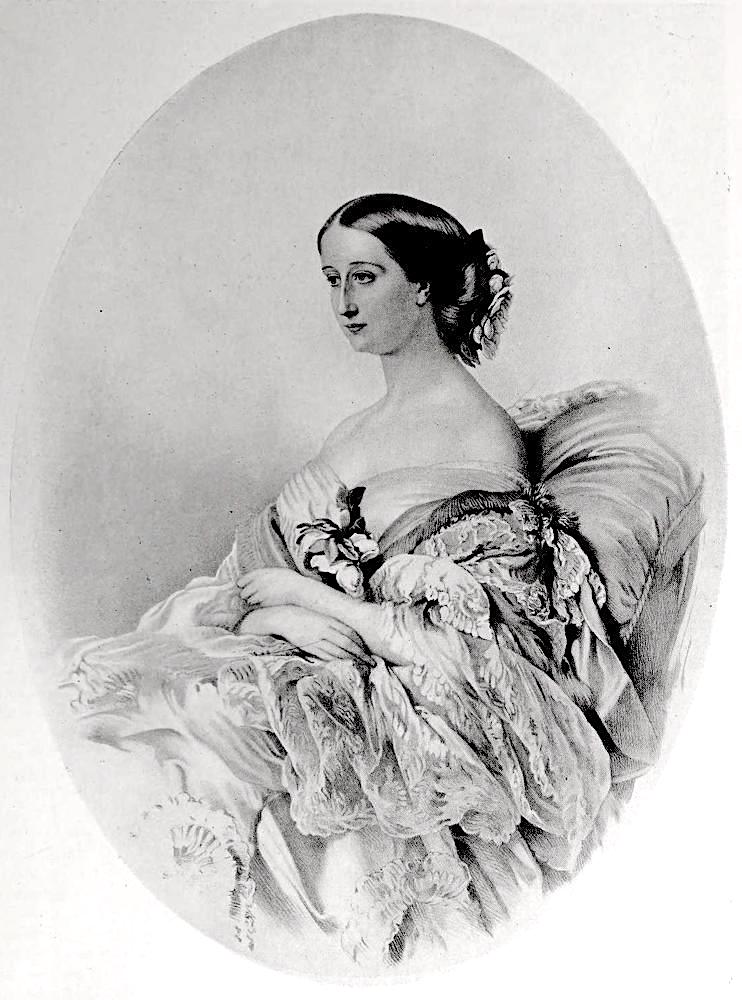
The Empress Eugénie by F. Winterhalter.
Then in 1852 Mr. Winterhalter's studio was bombarded by a crinoline swollen to nearly twice its ordinary size, with eighteen or twenty rows of flounces on it, and dozens of little bows and loops of ribbon and little rosebuds. Then began the reign of Organdy, Tarlatan, Barege, Crépe, Grenadine, and Gauze. And it was all the mode to wear an Algerian burnous, a moss rose in your hair, and a bracelet of gold and plaited hair on your arms.
Your fashionable portrait painter must bow to fate and fashion and go smoothly on as if the very grounds of art were not being swept away from under his feet. Of course there was a "something" about the crinoline that was rather delightful. It was, in a way, a precious casket for the fair one enshrined therein; but from the point of view of the artist who depends so much on the sweep and line of a figure to get his effects, this cage was a terrible difficulty, since it did away with every suggestion of form. Winterhalter did his very best; he realised that one cannot hide the charms of a beautiful woman, whatever her dressmaker may do, and that even if you make her the shape of a handbell, with her head for the handle, and build her dresses so that her shoulders slope like the neck of a champagne bottle, and part her hair in a wide parting in the middle and oil it down smooth over her ears, and then wrap her half up in a white silk and lace shawl, still the original Eve, the combination of child, goddess, and peacock will out; and if you area good honest painter with a little heaven-given vision, [132/134] you will see the real woman through all the mass of her delightful vanities.
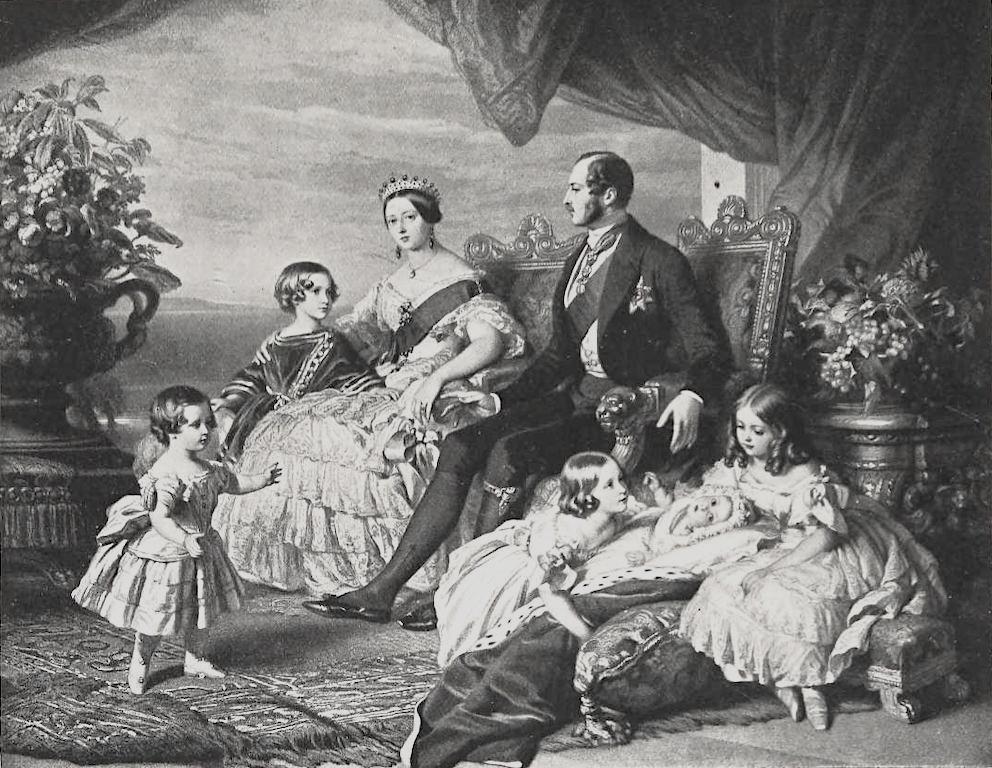
Queen Victoria and Her Family by F. Winterhalter.
Then, after 1856, the fashion went really mad. The crinoline with a mere set of twenty flounces was outdone by one of sixty, eighty, even a hundred. Doors had to be widened, getting into a carriage or a stall at the opera became a work of great art, only one woman could go up a staircase ata time. Mr. Winterhalter was confronted by the monster and nobly set it down, bows, flounces, ribbons and all, and topped it with a head of some beautiful woman.
Now, this painter has often been called mediocre, poor, third rate; but when one realises the difficulties he laboured under, it is easy to see how very hard it was to arrive at any high pitch. He certainly is not in the first rank of genius, but I think it may be claimed that he was quite in the first rank of talent, and one has only to take a few of the German painters of his time to see what could be done with the hideousness of his period. For instance, there are Danhauser, Anselm Feuerbach, and Kriiger, all men of his own time, whose pictures are exact and interesting mirrors of the costume and personality of the early nineteenth century.

The Duchess of Orleans by F. Winterhalter.
Just after 1860 the monstrous crinoline began to fade, and then came a fashion which was indeed one of the most graceful of any time. Then Winterhalter showed how he could paint easy and charming portraits; witness the portrait of the lady of the name of Worontzoff. "The reign of the crinoline was rapidly approaching an end, and in the seventies it had completely died out, after having remained for about ten years only in the mildest form, and really only as a stiffener for ball dresses. From 1860 to 1870 the wide voluminous skirts, adapting themselves to every movement of a woman's figure, gave all painters a chance, and it was not until about 1873 that the really terrible time came, far, far worse than that of the crinoline, when art suffered more, I suppose, than she ever suffered before, and, because of the suffering, [134/35] bred a new school with new ideas, new dreams, new We can see, by looking at the remarkably beautiful women drawn by Du Maurier, how truly melancholy was the reign of that monstrosity that succeeded the crinoline — the bustle; still, somehow art did marvels, and there are many beauties to be met in the drawings and paintings of the seventies.
This, possibly, is taking a very one-sided view in treating a man's art alongside the fashion of his day, but it seems to me that so much depends on clothes that one cannot divorce the crinoline from Winterhalter, just as one cannot think of those three-cornered head-dresses without Holbein, or Van Dyck apart from collars, or Romney away from fichus, or Watteau from a celebrated pleat.
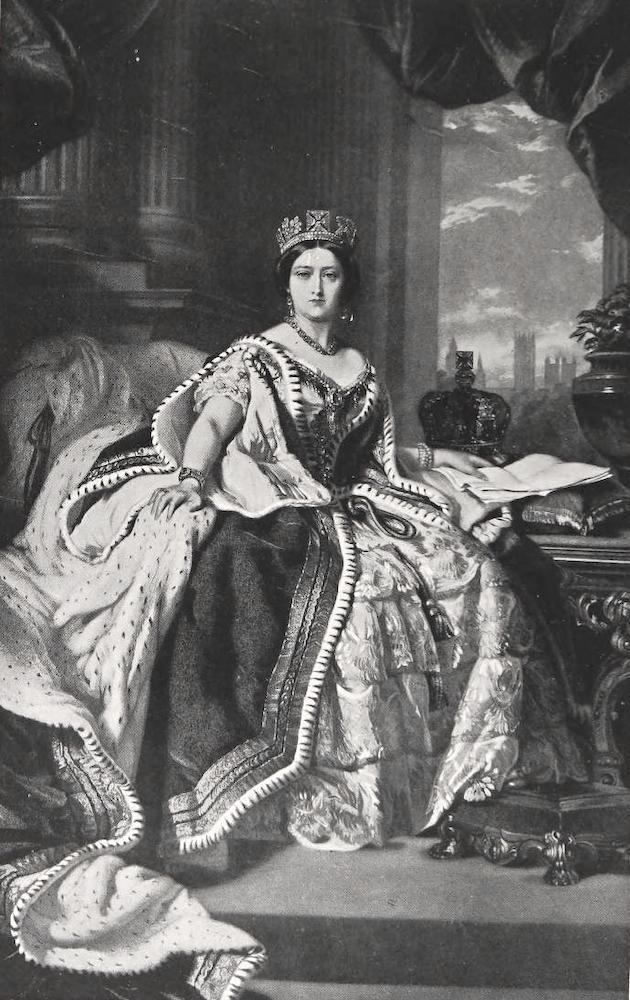
Queen Victoria, by F. Winterhalter.
Winterhalter was not, in the painter's sense of the word, a good painter. His quality is poor, his colour leaves much to be desired in the way of subtlety; but his arrangements are good, and he drew with real He will never be counted as an artist to whom one goes for any furtherance of artistic ideas, or for any purpose except to admire the delightful way he had of flattering pretty women. And I prefer his work, sound and good as it was, to much of the work of the present moment, that seems to preach only peculiarity, or ugliness, or try for some new way in which to achieve a vulgar notoriety.
In his own time Winterhalter suffered from much unjust adverse criticism that hurt him deeply, and just because he did not follow every new hare that was started, he was no doubt a constant butt for the So much did he feel the remarks made upon his art that he left twelve pictures sealed in a box to be opened fifty years after his death, that they might come new before a generation free from bias.
I am afraid the judgment of the new generation is much the same. He was just what he set out to be, a sound paintet of kings and queens, princesses and great ladies.
There is one thing more. It is to me an interesting thing to see how each age of women, each era, produces automatically some one artist whose province it seems to be to set down the feminine note of his [136-37] time for all future ages to see. Now and again the artist is great enough to grip the whole spirit of his own age and to paint, like Sargent at the present moment, the very feeling of the time into all his wonderful gallery. And now at the present day, when we are getting more acquainted with the art of the world, it is quite amazing to be able to look on photographs of paintings back and back as far as portraiture goes, and to notice that it is always a man who sets down the woman in full and complete understanding, and that no great portrait of a woman by a woman appears in the vista.
Links to Related Material
- Fashion and Costume, 1850-1900: A Summary Overview
- Matters of Dress: Crinolines in Punch (sitemap)
- Illustrations and articles from Fun (sitemap: see "Satirical Views of Fashion")
- High Victorian Jewellery and the Second Empire
Bibliography
Calthrop, Dion Clayton. "Winterhalter and the Crinoline." The Connoisseur, Vol. 31 (November 1911): 131-38. Internet Archive. Web. 30 July 2024.
Created 30 July 2024